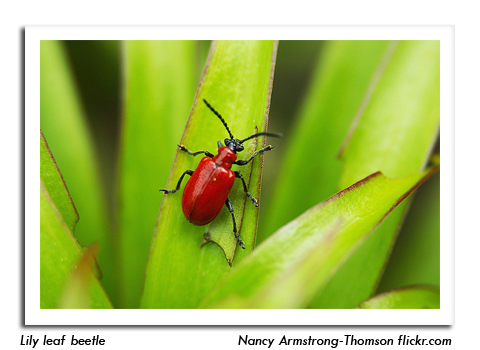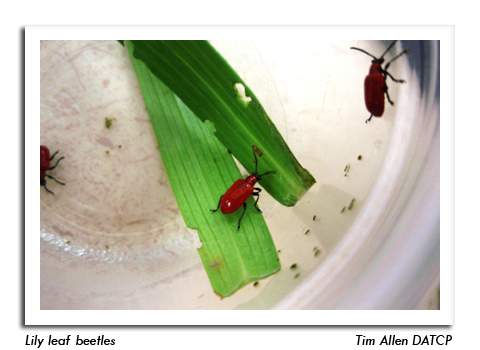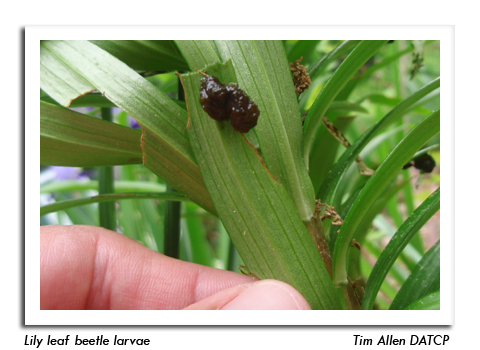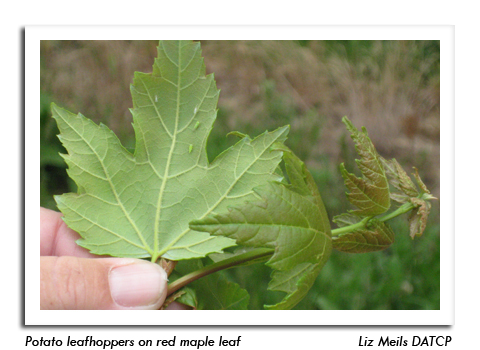
 |
|
|
Nursery & Forest
Volume 59 Number 16 Date 08/21/2014 LILY LEAF BEETLE - A number of reports were received this week from the Mosinee area of Marathon County where this newly-introduced exotic pest was discovered last month. The adult beetles and larvae have been observed on lilies in more than a dozen Marathon County nurseries and residences since early July. One unconfirmed report indicates the beetle was also found near Marshfield in adjacent Wood County. Residents of Marathon and Wood counties, especially Kronenwetter, Marshfield, Mosinee and Rothschild, are encouraged to closely inspect their lilies for this very distinctive bright red beetle and report any suspected infestations to the DATCP nursery program: datcpnursery@wisconsin.gov. Control---either by manually removing the adults and larvae or applying an insecticide to infested plants---is strongly recommended to prevent this destructive lily pest from spreading throughout the state. Most chemical products labeled for ornamentals and containing carbaryl, malathion or cyfluthrin (a pyrethroid) available at hardware stores or big box retailers are effective against the LLB. It is not known when this insect first arrived in the state or if it is permanently established. Hosts include true lilies (Asiatic and Oriental, Easter, Turk's cap, tiger) and fritillaria, but not day lilies. PHOMOPSIS TIP BLIGHT - A nursery inspector's report indicates that this evergreen disease is infecting several varieties of juniper in Ozaukee and Washington counties. Plants with phomopsis blight develop yellow spots at the shoot tips of young needles that progress to the stems, causing gradual dieback of new growth and eventual death of the infected branch. The black pycnidia or fruiting bodies which develop on the dead branches are diagnostic. The occurrence of phomopsis can be reduced by pruning out symptomatic branches and twigs 4-6 inches below the diseased area, and disinfecting pruning shears between each cut. Maintaining adequate spacing and airflow between plantings will also help to prevent its spread. LEAFHOPPER DAMAGE - Honey locust and maple trees at nurseries in Ozaukee and Washington counties are showing leaf cupping and tip burn, typical symptoms of leafhopper feeding injury. Harvest of nearby third-crop alfalfa is thought to have forced the leafhoppers out of alfalfa and onto the trees. Treatment of the affected honey locusts and maples was not needed in this instance, but may be justified when large numbers of leafhoppers are present and symptoms are obvious. OYSTERSHELL SCALE - A moderate infestation of this scale was found on ash trees at a nursery in Ozaukee County. This insect infests apple, birch, cotoneaster, dogwood, elm, lilac, maple, willow and about 50 other woody plant species, in addition to ash. Horticultural oils and soaps or conventional insecticides are effective against the first and second generations of mobile crawlers in the intervals between 275-500 degree days (base 50°F) and 1,600-1,700 degree days, respectively. Treatment remains an option for southeastern, central, and northern Wisconsin, but is not advised for advanced southern and western parts of the state where 1,700 degree days have been surpassed and the scales have adhered to the branches and begun to form their protective waxy coverings. BOXWOOD PSYLLID - Light infestations of this insect were observed on boxwoods during inspections this week. Feeding by the immature nymphs on tender new growth in spring causes foliage to become cupped and distorted. The psyllid nymphs remain protected within the cupped foliage and continue to feed throughout the season. Damage resulting from their feeding is usually minimal and treatment is seldom needed. -- Ellen Hermanson, DATCP Nursery Inspector 





|
|
|